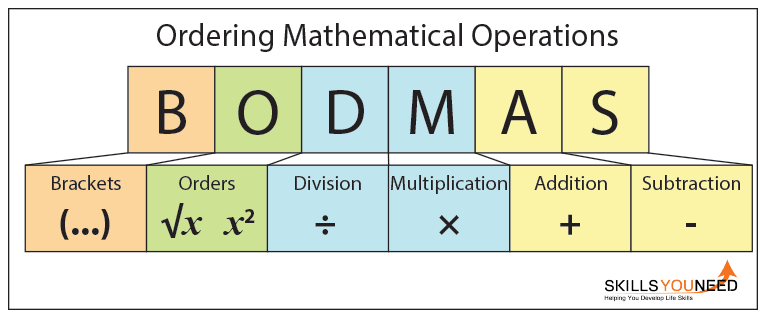Ordering Mathematical Operations | BODMAS
See also: Positive and Negative NumbersFor a calculation that has only one mathematical operation with two numbers, it is a simple case of either adding, subtracting, multiplying or dividing to find your answer.
But what about when there are several numbers, and different operations? Maybe you need to divide and multiply, or add and divide. What do you do then?
Fortunately, mathematics is a logic-based discipline. As so often, there are some simple rules to follow that help you work out the order in which to do the calculation. These are known as the ‘Order of Operations’.
Rules of Ordering in Mathematics - BODMAS

BODMAS is a useful acronym that tells you the order in which you solve mathematical problems. It's important that you follow the rules of BODMAS, because without it your answers can be wrong.
The BODMAS acronym is for:
- Brackets (parts of a calculation inside brackets always come first).
- Orders (numbers involving powers or square roots).
- Division.
- Multiplication.
- Addition.
- Subtraction.
BODMAS, BIDMAS or PEMDAS?
You may often see BIDMAS instead of BODMAS. They are exactly the same. In BIDMAS, the ‘I’ refers to Indices, which are the same as Orders. For more information, see our page on Special Numbers and Concepts.
PEMDAS
PEMDAS is commonly used the in USA it works the same as BODMAS. The PEMDAS acronym is:
Parentheses,
Exponents (powers and roots),
Multiplication and Division,
Addition and Subtraction.
Further Reading from Skills You Need
The Skills You Need Guide to Numeracy

This four-part guide takes you through the basics of numeracy from arithmetic to algebra, with stops in between at fractions, decimals, geometry and statistics.
Whether you want to brush up on your basics, or help your children with their learning, this is the book for you.
Using BODMAS
Brackets
Start with anything inside brackets, going from left to right.
Example:
4 × (3 + 2) = ?
You need to do the operation, inside the brackets first, 3 + 2, then multiply the answer by 4.
3 + 2 = 5.
4 × 5 = 20
If you ignored the brackets and did your calculation from left to right 4 × 3 + 2 you would get 14. You can see how the brackets make a difference to the answer.
Orders
Do anything involving a power or a square root next (these are also known as orders), again working from left to right if there is more than one.
Example:
32 + 5 = ?
You need to calculate the power first, before you can add 5.
32 = 3 × 3 = 9
9 + 5 = 14
Division and Multiplication
Once you have done any parts of the calculation involving brackets or powers the next step is division and multiplication.
Multiplication and division rank equally, so you work from left to right in the sum, doing each operation in the order in which it appears.
Example:
6 ÷ 2 + 7 × 4 = ?
You need to do division and multiplication first, but you have one of each.
Start from the left and work across to the right, which means that you start with 6 ÷ 2 = 3. Then do the multiplication, 7 × 4 = 28.
Your calculation is now 3 + 28.
Complete the addition calculation to find the answer, 31.
See our pages: Multiplication and Division for more.
Addition and Subtraction
The final step is to calculate any addition or subtraction. Again, subtraction and addition rank equally, and you simply work from left to right.
Example:
4 + 6 − 7 + 3 = ?
You start on the left and work your way across.
4 + 6 = 10
10 − 7 = 3
3 + 3 = 6
The answer is 6.
See our pages: Addition and Subtraction for more.
Bringing It All Together
This final worked example includes all elements of BODMAS.
Example:
4 + 82 × (30 ÷ 5) = ?
Start with the calculation inside the brackets.
30 ÷ 5 = 6
This gives you 4 + 82 × 6 = ?
Then calculate the orders - in this case the square of 8.
82 = 64
Your calculation is now 4 + 64 × 6
Then move to the multiplication 64 × 6 = 384
Finally perform the addition. 4 + 384 = 388
The answer is 388.
BODMAS Test Questions
The rules of BODMAS are easiest to understand with some practice and examples.
Try these calculations yourself and then open up the box (click on the + symbol to the left) to see the workings and answers.
There are no brackets or orders in this calculation.
- Multiplication comes before addition, so start with 20 × 3 = 60.
- The calculation now reads 3 + 60
The answer is therefore 63.
- Start with brackets. (3 + 2) = 5.
- The calculation now reads 25 − 5 ÷ 5
- Division comes before subtraction. 5 ÷ 5 = 1.
- The calculation now reads 25 − 1
The answer is therefore 24.
- Start with brackets. (1+10) = 11.
- The calculation now reads 10 + 6 × 11
- Multiplication comes before addition. 6 × 11 = 66.
- The calculation now reads 10 + 66.
The answer is therefore 76.
When there is no sign like in this calculation, the operator is a multiplication, the same as writing 5 × (3 + 2) + 52.
- Complete the calculation inside the brackets first: (3 + 2) = 5.
- That gives you 5 × 5 + 52.
- The next step is orders, in this case, the square. 52 = 5 × 5 = 25. Now you have 5 × 5 + 25.
- Division and multiplication come before addition and subtraction, so your next step is 5 × 5 = 25. Now the calculation reads 25 + 25 = 50.
The answer is 50.
This one has everything! But don’t panic. BODMAS still applies, and all you have to do is unpick the calculation.
- Start with brackets. (105 + 206) = 311.
- The calculation now reads 311 – 550 ÷ 52 + 10
- Next, orders or powers. In this case, that’s 52 = 25.
- The calculation now reads 311 – 550 ÷ 25 + 10
- Next, division and multiplication. There is no multiplication, but the division is 550 ÷ 25 = 22.
- Now the calculation reads 311 – 22 + 10.
- Although you still have two operations left, addition and subtraction rank equally, so you just go from left to right. 311 – 22 = 289, and 289 + 10 = 299.
The answer is 299.
Problems like this often do the rounds on social media sites, with captions like '90% of people get this wrong'. Just follow the rules of BODMAS to get the correct answer.
- There are no brackets or orders so start with division and multiplication.
- 7 ÷ 7 = 1 and 7 × 7 = 49.
- The calculation now reads 7 + 1 + 49 – 7
- Now do the addition and subtraction. 7 + 1 + 49 = 57 – 7 = 50
The answer is therefore 50.
How Did You Do?
Hopefully you managed to get all the answers right. If not, go back and review where you went wrong, and read over the rules again.
The more you practise, the easier BODMAS becomes and eventually you won’t even have to think about it.
Continue to:
Fractions
Averages (Mean, Median and Mode)

